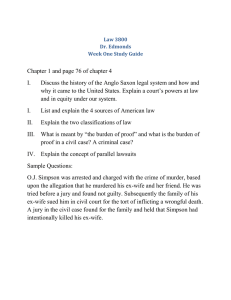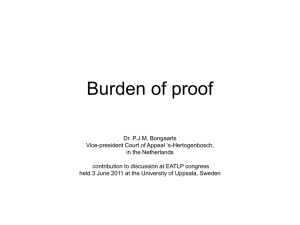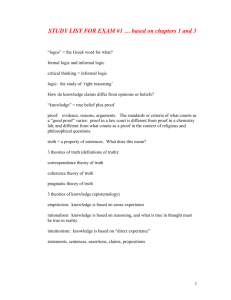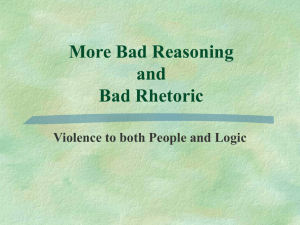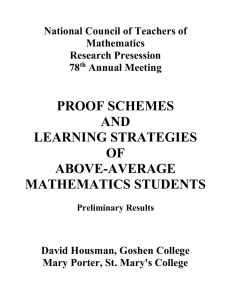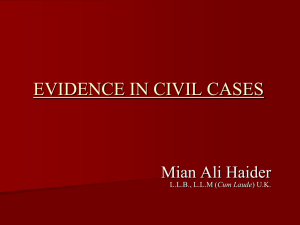The Adversary System - LegalStudiesYr12LSC
advertisement
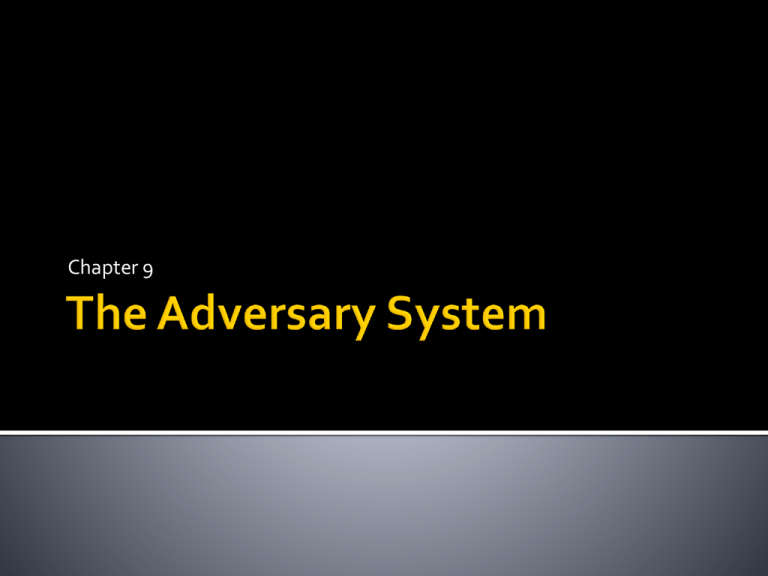
Chapter 9 ... is based on two parties battling to win the case, each acting as the adversary of the other. ROLE: to provide a procedure for the parties to present and resolve their case, in as fair a manner as possible. 5. The Need for Rules of Evidence and Procedure 1. The Role of the Parties (party control) The Adversary System 2. The Role of the Judge (impartial arbiter) 4. The need for Legal Representation 3. The Burden of Proof and Standard of Proof Each party controls their own case and has control over the decisions about how the case will run as long as the rules of evidence and procedure are followed. Instigating proceedings Investigating the facts Deciding which facts should be brought before the court 4. Investigating the law 5. Deciding whether to have a jury in a civil case 6. Choosing whether to have legal representation 1. 2. 3. Party control allows the parties to feel that they are in control of the situation and responsible for the outcome. It satisfies the competitive or combative spirit When given the opportunity to fight to win people generally more satisfied with the outcome Judge or magistrates is (an Impartial umpire) (Keeps contest fair) The role is to ensure the courts processes and procedures are carried out according to strict rules of evidence and procedure and each party is treated fairly. Judge generally not allowed to interfere or favour any side – rather can ask questions, recall witnesses etc with permission of both parties. (ensure onus of proof is discharged) decides the admissibility of evidence and decides the questions of law If the judge or magistrates favours one side then the contest would not be fair. The decision maker (if no jury) must be independent – no previous knowledge of the accused or parties in civil case. Should not have any opportunity to form any preconceived ideas before the trial/hearing and must set aside personal biases. Burden of proof – lies with the person who is bringing the case. E.g. Criminal case prosecution and Civil case Plaintiff The person who brings the case has to prove their view of the facts is correct Standard of proof - the strength of the evidence needed to prove the case E.g. Criminal cases – Beyond Reasonable Doubt a in civil cases Balance of Probability The burden of proof indicates who must begin the battle. The standard of proof indicates the strength of proof required to decide who is successfull Role of preparing and conducting a case usually undertaken by legal representatives on behalf of the parties Legal representatives are experts who are familiar with rules of evidence and procedure Experts ensure parties are able to present their best possible case and assist in achieving a just outcome. The truth should emerge from each party representing their own case to the best of their ability and the other side showing the flaws in the evidence presented Presenting a case without legal rep may therefore result in an unjust outcome because parties might not know how to bring out the evidence. (linked to rules of evidence and procedure) To work effectively – should have equal representation. If one party is better represented this could lead to an unfair advantage and possibly an incorrect result. Each hearing or trial governed by rules of evidence which aim to ensure fair and equal treatment. Evidence – oral or written form (sworn statements –affidavits), objects, (e.g. Murder weapon, stolen goods, photos diagram or tape recordings), a set of circumstances or facts indicated (circumstantial evidence – where inferences can be drawn from facts) Ensure: The parties are treated fairly The jury is not distracted by irrelevant material Unreliable or illegally obtained evidence is not heard by the court Evidence is not unduly prejudicial to the defendant (eg bad character not given) In criminal case only evidence about the case – not prior convictions (except where propensity evidence given) Provide a framework in which the court cases can take place and resolution achieved Establishes steps for bringing out the evidence e.g. Oral evidence, and cross examination (the truth should emerge) Procedure aims to treat both sides equally and fairly and creating an atmosphere of respect so that parties will follow the decision of the court Summarise 456 to 463 Question 1 to 16 page 463 Read Pages 465 to 469 Questions 17 to 22 page 470 Complete the Advantages and Disadvantages worksheet GROUP WORK In your Group you are to take one element of the adversary system and write a detailed response that illustrates how the element is both an advantage and disadvantage. Present this to the class – each member must contribute!!! Read and summarise pages 471 to 480 Complete only Q23 page 477

